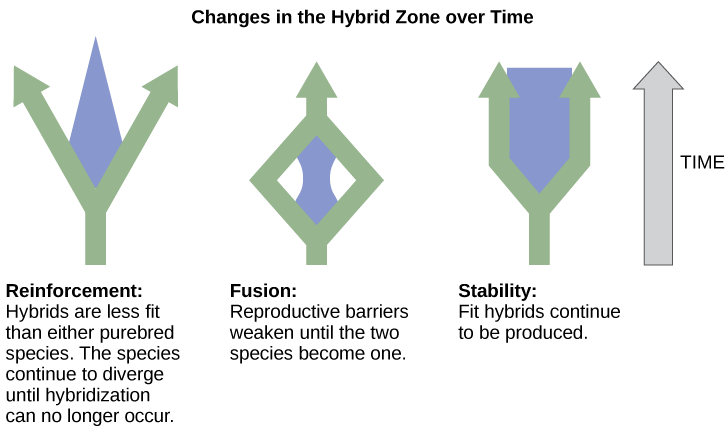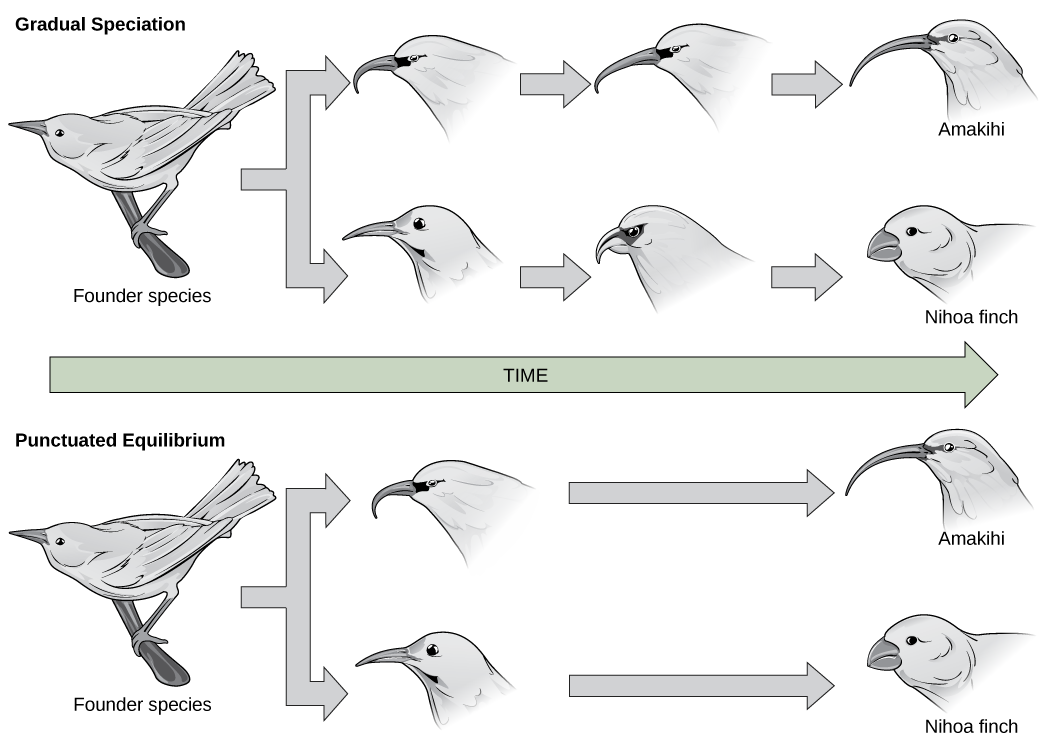| << Chapter < Page | Chapter >> Page > |
Speciation occurs over a span of evolutionary time, so when a new species arises, there is a transition period during which the closely related species continue to interact.
After speciation, two species may recombine or even continue interacting indefinitely. Individual organisms will mate with any nearby individual who they are capable of breeding with. An area where two closely related species continue to interact and reproduce, forming hybrids, is called a hybrid zone . Over time, the hybrid zone may change depending on the fitness of the hybrids and the reproductive barriers ( [link] ). If the hybrids are less fit than the parents, reinforcement of speciation occurs, and the species continue to diverge until they can no longer mate and produce viable offspring. If reproductive barriers weaken, fusion occurs and the two species become one. Barriers remain the same if hybrids are fit and reproductive: stability may occur and hybridization continues.

If two species eat a different diet but one of the food sources is eliminated and both species are forced to eat the same foods, what change in the hybrid zone is most likely to occur?
Hybrids can be either less fit than the parents, more fit, or about the same. Usually hybrids tend to be less fit; therefore, such reproduction diminishes over time, nudging the two species to diverge further in a process called reinforcement . This term is used because the low success of the hybrids reinforces the original speciation. If the hybrids are as fit or more fit than the parents, the two species may fuse back into one species ( [link] ). Scientists have also observed that sometimes two species will remain separate but also continue to interact to produce some hybrid individuals; this is classified as stability because no real net change is taking place.
Scientists around the world study speciation, documenting observations both of living organisms and those found in the fossil record. As their ideas take shape and as research reveals new details about how life evolves, they develop models to help explain rates of speciation. In terms of how quickly speciation occurs, two patterns are currently observed: gradual speciation model and punctuated equilibrium model.
In the gradual speciation model , species diverge gradually over time in small steps. In the punctuated equilibrium model, a new species undergoes changes quickly from the parent species, and then remains largely unchanged for long periods of time afterward ( [link] ). This early change model is called punctuated equilibrium, because it begins with a punctuated or periodic change and then remains in balance afterward. While punctuated equilibrium suggests a faster tempo, it does not necessarily exclude gradualism.

Which of the following statements is false?
The primary influencing factor on changes in speciation rate is environmental conditions. Under some conditions, selection occurs quickly or radically. Consider a species of snails that had been living with the same basic form for many thousands of years. Layers of their fossils would appear similar for a long time. When a change in the environment takes place—such as a drop in the water level—a small number of organisms are separated from the rest in a brief period of time, essentially forming one large and one tiny population. The tiny population faces new environmental conditions. Because its gene pool quickly became so small, any variation that surfaces and that aids in surviving the new conditions becomes the predominant form.
Visit this website to continue the speciation story of the snails.
Speciation is not a precise division: overlap between closely related species can occur in areas called hybrid zones. Organisms reproduce with other similar organisms. The fitness of these hybrid offspring can affect the evolutionary path of the two species. Scientists propose two models for the rate of speciation: one model illustrates how a species can change slowly over time; the other model demonstrates how change can occur quickly from a parent generation to a new species. Both models continue to follow the patterns of natural selection.
[link] If two species eat a different diet but one of the food sources is eliminated and both species are forced to eat the same foods, what change in the hybrid zone is most likely to occur?
[link] Fusion is most likely to occur because the two species will interact more and similar traits in food acquisition will be selected.
[link] Which of the following statements is false?
[link] Answer B

Notification Switch
Would you like to follow the 'Biology' conversation and receive update notifications?